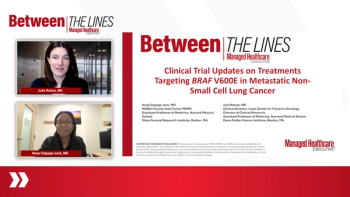
Using Real-World Evidence to Advocate for DTx and PDTs
A panel of specialists focus on how real-world evidence affects the use and acceptance of digital therapeutics and prescription digital therapeutics, as well as FDA approvals.
Episodes in this series

John Fox, MD: As Scott pointed out, a lot of health plans look at those clinical trials and say, “I’m not ready to do that.” But there are times [when] real-world evidence, including compliance, persistence, and clinical outcomes, can be a [deciding factor]. Tim, in your experience, is this a good space to be collecting that type of real-world evidence?
Timothy Aungst, PharmD: This will fall within this conversation because you’ve seen some people in digital health go from business to consumer, from B to C, and are now trying to go from business to consumer to business. They’ve had all these data they’ve collected. They’ve shown that they can work pretty well, and they want to go back to payers and say, “Cover us for the level of service we can provide.” There are a lot in mental health who have done this. The B-to-C-to-B model is now popping up, which is quite interesting because they basically went to the consumers so [consumers] could speak for them and advocate for them and say, “We love this product.” They have brand awareness across the whole sphere.
One of my biggest critiques about that has been where they’re getting evidence from, the [demographics]. One area that I’m concerned about is what I call triple-down digital health evidence. You basically went to your main clientele, and your main evidence was a well-off White population. That’s going to be a huge disservice if you want to take that evidence and go back to someone else and say, “It worked.” They’ll comb through your data and say, “That isn’t our clientele. Those aren’t our patient demographics.”
We talked all about social determinants of health and all that stuff, but looking at it in play here, how can you say that your adherence level and outcomes are going to be the same as our patients experience? That’s a big thing. This is why the FDA has been very curious about how these data are generated through AI [artificial intelligence]/ML [machine learning] models, where that stuff is coming from. They want to check whether this represents an [accurate] clientele.
To come back to the other talk about pharmacotherapeutics and placebos and everything else like that, we also see that in our RCTs [randomized controlled trials] for medications. If you look at the population that goes on [RCTs] vs [those who don’t], it’s the same thing. Is there a double standard here? Is this something that we have to put in a package insert or something to clarify? I’m not too sure, but those data are going to be a double-edged sword in terms of real-world evidence. You’re going to see that there’s a huge clientele for it, but you can automatically see who that was. How are you going to broaden those data and expect the same outcomes for someone else? Someone is going to have to come back to that and think about it.
Scott Whittle, MD: I love that. In fact, I completely agree. I believe the trend is to show that prescription digital therapeutics [PDTs] actually buck that trend by showing that. For example, the one I most commonly use is more effective in the Medicaid space than in the commercial space. I think that’s because of the level of evidence that’s needed to go through the FDA and the focus to try to be more equitable in the distribution and creation of the product.
If you come from a wellness perceptive into the space of behavioral health, you’re susceptible to the equity bias you’re describing. But if your focus is to create an actual therapeutic when pointed at a diagnosis that shows real-world outcomes, you come from the other side. You come from the side of thinking, how do we take evidence-based care and put that evidence-based care into the health care desert that we all know exists? I’m pretty persuaded that a lot of the positive outcomes we see with prescription digital therapeutics in populations like Medicaid are so robust. Because otherwise, as we pointed out, care is very hard to come by. You’re talking about a very engaging patient-centric strategy where otherwise, almost nothing exists.
Timothy Aungst, PharmD: That’s where we’re going to see a lot of the PDTs vs the DTx [digital therapeutics] space. That’s where that whole comparison is going to come down to then. If we want to balance on the evidence, someone is going to have to take a step back and say, “What’s the indication? What are you using it for? Where did it come from?” and those outcomes associated with it. To your point, the wellness project is trying to get into this space. They’re probably going to have a harder [time] than they realize just because they already have these incumbents who came from the other direction.
Transcript edited for clarity.
Newsletter
Get the latest industry news, event updates, and more from Managed healthcare Executive.


















































